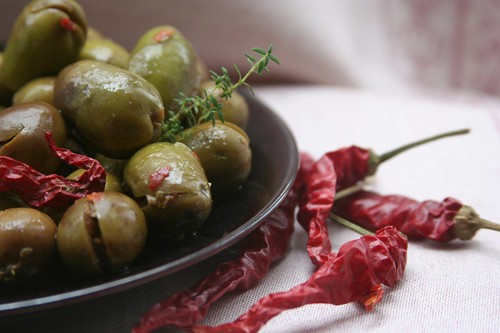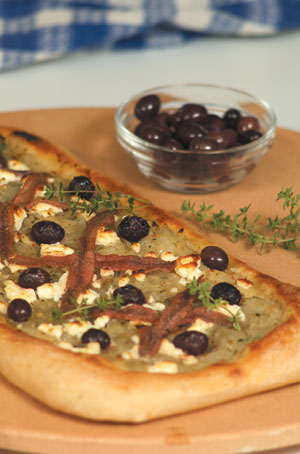
The silvery green leaves of the olivier (“olive tree”) stay on its branches all year long and are easy to spot throughout the southern-most regions of France: Provence-Côte d’Azur and Languedoc-Roussillon. One sees the gnarled trunks of the low-cut trees lined up in groves, along the side of the autoroute, or in pots as ornamentals in people’s yards. Over a hundred different olive varieties exist and, while the trees generally take three decades to reach maturity, they can live as long as a thousand years! No wonder Van Gogh and other artists have made them the subject of many paintings.

According to what I’ve read, olives, along with grapes, were among the first cultivated crops. When you think about it, the two plants have a lot in common. Both can be grown simply for their fruit or the fruit can be crushed and made into a whole different product, i.e. olive oil and wine. The end results are affected by differences of varietal, the amount of sunshine, the soil and overall climate, when and how the crops are harvested, and, ultimately, the production methods.
Olives have to be harvested carefully and quickly, no matter if the fruit is intended to be consumed directly or to be used for olive oil. Hand-picking yields the best outcome, but olive branches are sometimes gently combed with a tool called une perche à peigne. It is important, however, that the fragile fruit doesn’t hit the ground, so a large net (un filet) is suspended or stretched out on the ground to cushion its fall.
 The most perfect specimens are treated with a kind of brine and later spiced in some way, with garlic, herbs, chili peppers, pimento, or anchovies, for example, eventually making their way to the dinner table. Others are transported to un moulin à huile, where they are ground and their oil is extracted. Even individuals having several trees in their yard can gather up 200 kilos of olives and have their own oil pressed at a mill.
The most perfect specimens are treated with a kind of brine and later spiced in some way, with garlic, herbs, chili peppers, pimento, or anchovies, for example, eventually making their way to the dinner table. Others are transported to un moulin à huile, where they are ground and their oil is extracted. Even individuals having several trees in their yard can gather up 200 kilos of olives and have their own oil pressed at a mill.Three countries in Europe presently account for 93% of the worldwide commercial production of olive oil: Spain, Italy, and Greece. France lags far behind in large part because of an event referred to as le grand gel, a frost in 1956 which reduced the number of French olive trees drastically from around 300,000 to about 70,000 today. Yet, French olive oil is considered one of the finest because of the types of olives grown here (which are not bitter), as well as the country’s strict standards. Eight areas have been classified as appellation d’origine contrôlée, insuring top quality. A woman selling oil at a marché in Lourmarin on Friday told us always to look for A.O.C. on the label, since certain producers "borrow" the big names such as Nyons in order to sell inferior products.
The French have several excellent recipes using olives. A couple of hors-d’œuvres ideas include a tasty spread for crackers or bread named tapenade which can be made with either green
 (unripe) or black (ripe) olives and cake aux olives. I never tried the latter, but it sounds delicious to me. As for main dishes, there are two recipes from Nice which both use the small, tart niçoise olive: the traditional salade niçoise and pissaladière, a kind of onion, olive, and anchovy pizza without tomato sauce. And with that I’ll say bon appétit!
(unripe) or black (ripe) olives and cake aux olives. I never tried the latter, but it sounds delicious to me. As for main dishes, there are two recipes from Nice which both use the small, tart niçoise olive: the traditional salade niçoise and pissaladière, a kind of onion, olive, and anchovy pizza without tomato sauce. And with that I’ll say bon appétit!

2 comments:
The anchovy pizza makes my mouth water.Yum. Lena
Yes, I love that picture. We should try to make it sometime!!!
Post a Comment